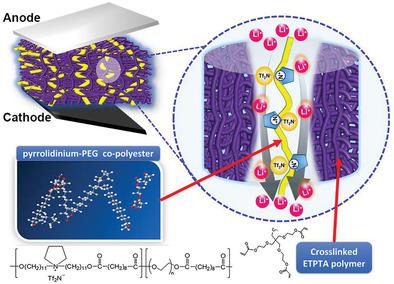当前位置:
X-MOL 学术
›
Adv. Energy Mater.
›
论文详情
Our official English website, www.x-mol.net, welcomes your
feedback! (Note: you will need to create a separate account there.)
Pyrrolidinium-PEG Ionic Copolyester: Li-Ion Accelerator in Polymer Network Solid-State Electrolytes
Advanced Energy Materials ( IF 24.4 ) Pub Date : 2021-10-13 , DOI: 10.1002/aenm.202102660 Young Gyun Choi 1 , Jong Chan Shin 2 , Anseong Park 3 , Young Min Jeon 1 , Jin Il Kim 1 , Sebin Kim 3 , Seulwoo Kim 3 , Won Bo Lee 3 , Minjae Lee 2 , Jong Hyeok Park 1
Advanced Energy Materials ( IF 24.4 ) Pub Date : 2021-10-13 , DOI: 10.1002/aenm.202102660 Young Gyun Choi 1 , Jong Chan Shin 2 , Anseong Park 3 , Young Min Jeon 1 , Jin Il Kim 1 , Sebin Kim 3 , Seulwoo Kim 3 , Won Bo Lee 3 , Minjae Lee 2 , Jong Hyeok Park 1
Affiliation

|
Nonflammable lithium-ion batteries (LIBs) are developed by adapting polymer solid electrolytes, but their insufficient electrochemical performance has not been fully addressed to date. Crosslinked polymer gel electrolytes with minimal organic solvents (hard gels) are proven to be nonflammable electrolytes, but their lithium metal battery performance is not comparable to those of conventional liquid electrolyte-based systems. Here, a semi-interpenetrating polymer network (semi-IPN) ion-transporting solid film that comprises a UV-curable crosslinked polymer and tailored linear pyrrolidinium-polyethylene glycol copolyester ion channels (named PNPEG), is reported. PNPEG can solvate Li+ effectively with the help of carbonate solvents. Molecular dynamics (MD) simulations confirm that Li+ transportation is accelerated due to the weaker interaction between PNPEG and Li+ ions than between the solvents and ions. The semi-IPN electrolyte with PNPEG exhibits a flexible, nonflammable nature with an ionic conductivity of 4.2 × 10−1 mS cm−1 and Li+ transference number of 0.51. The individual pyrrolidinium-Bis(trifluoromethanesulfonyl)imide (pyrrolidinium-Tf2N) monomer and PEG chain ratios in PNPEG strongly affect battery performance, and the optimized semi-IPN-based lithium metal half cells with LiCoO2 cathodes show greatly improved discharge capacity retention at high c-rate conditions owing to effective Li+ transportation and excellent cycling performance (93.8% capacity retention after 200 cycles at 0.5 C).
中文翻译:

吡咯烷-PEG 离子共聚酯:聚合物网络固态电解质中的锂离子加速剂
不可燃锂离子电池(LIBs)是通过采用聚合物固体电解质开发的,但迄今为止,其电化学性能不足的问题尚未得到充分解决。具有最少有机溶剂(硬凝胶)的交联聚合物凝胶电解质被证明是不可燃的电解质,但它们的锂金属电池性能无法与传统的基于液体电解质的系统相比。在这里,报道了一种半互穿聚合物网络 (semi-IPN) 离子传输固体薄膜,该薄膜包含可紫外线固化的交联聚合物和定制的线性吡咯烷鎓-聚乙二醇共聚酯离子通道(命名为 P N PEG)。P N PEG 可以溶剂化 Li +在碳酸酯溶剂的帮助下有效。分子动力学 (MD) 模拟证实,由于 P N PEG 和 Li +离子之间的相互作用比溶剂和离子之间的相互作用弱,因此 Li +运输加速。具有 P N PEG的半 IPN 电解质具有柔性、不可燃的特性,离子电导率为 4.2 × 10 -1 mS cm -1,Li +迁移数为 0.51。P N 中的单个吡咯烷鎓-双(三氟甲磺酰基)亚胺(吡咯烷鎓-Tf 2 N)单体和 PEG 链比率PEG 强烈影响电池性能,优化的半 IPN 基锂金属半电池与 LiCoO 2正极由于有效的 Li +传输和优异的循环性能(93.8% 0.5 C 下 200 次循环)。
更新日期:2021-11-24
中文翻译:

吡咯烷-PEG 离子共聚酯:聚合物网络固态电解质中的锂离子加速剂
不可燃锂离子电池(LIBs)是通过采用聚合物固体电解质开发的,但迄今为止,其电化学性能不足的问题尚未得到充分解决。具有最少有机溶剂(硬凝胶)的交联聚合物凝胶电解质被证明是不可燃的电解质,但它们的锂金属电池性能无法与传统的基于液体电解质的系统相比。在这里,报道了一种半互穿聚合物网络 (semi-IPN) 离子传输固体薄膜,该薄膜包含可紫外线固化的交联聚合物和定制的线性吡咯烷鎓-聚乙二醇共聚酯离子通道(命名为 P N PEG)。P N PEG 可以溶剂化 Li +在碳酸酯溶剂的帮助下有效。分子动力学 (MD) 模拟证实,由于 P N PEG 和 Li +离子之间的相互作用比溶剂和离子之间的相互作用弱,因此 Li +运输加速。具有 P N PEG的半 IPN 电解质具有柔性、不可燃的特性,离子电导率为 4.2 × 10 -1 mS cm -1,Li +迁移数为 0.51。P N 中的单个吡咯烷鎓-双(三氟甲磺酰基)亚胺(吡咯烷鎓-Tf 2 N)单体和 PEG 链比率PEG 强烈影响电池性能,优化的半 IPN 基锂金属半电池与 LiCoO 2正极由于有效的 Li +传输和优异的循环性能(93.8% 0.5 C 下 200 次循环)。











































 京公网安备 11010802027423号
京公网安备 11010802027423号